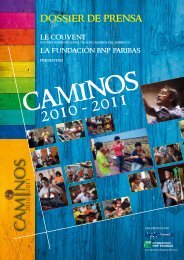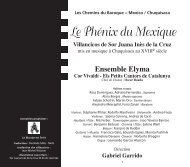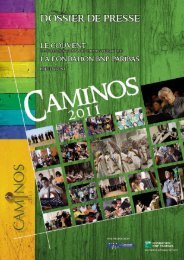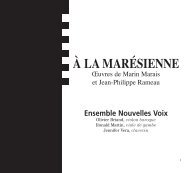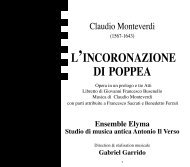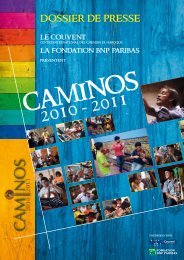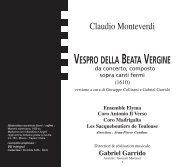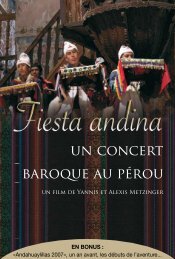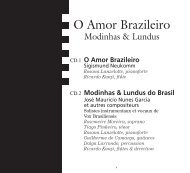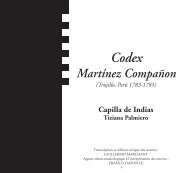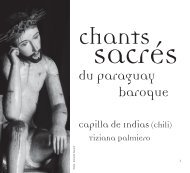Musique et poésie des Juifs en Italie à la Renaissance Music and ...
Musique et poésie des Juifs en Italie à la Renaissance Music and ...
Musique et poésie des Juifs en Italie à la Renaissance Music and ...
- No tags were found...
Create successful ePaper yourself
Turn your PDF publications into a flip-book with our unique Google optimized e-Paper software.
Les sources littéraires du XVI e siècle attest<strong>en</strong>t queles <strong>Juifs</strong> d’<strong>Italie</strong> se consacrai<strong>en</strong>t au chant <strong>des</strong> poèmesavec le même <strong>en</strong>thousiasme que <strong>la</strong> popu<strong>la</strong>tion qui les<strong>en</strong>tourait.La Istoria de Purim io ve raconto de Mordekai Dato, unintellectuel émili<strong>en</strong>, est un <strong>des</strong> innombrables poèmes <strong>en</strong>ottava rima. Il s’agit d’une vulgarisation de <strong>la</strong> Megil<strong>la</strong>tEsther, l’histoire de <strong>la</strong> reine Esther, écrite <strong>en</strong> <strong>la</strong>ngueitali<strong>en</strong>ne, mais <strong>en</strong> caractères hébraïques. Son butétait de contribuer à l’édification <strong>des</strong> <strong>en</strong>fants <strong>et</strong> <strong>des</strong>femmes de <strong>la</strong> communauté, qui savai<strong>en</strong>t lire mais quine compr<strong>en</strong>ai<strong>en</strong>t pas l’hébreu, <strong>la</strong>ngue sacrée, <strong>des</strong>tinéeaux étu<strong>des</strong> <strong>et</strong> à <strong>la</strong> liturgie, deux domaines strictem<strong>en</strong>tréservés aux hommes.Le texte, qui expose l’histoire de façon vivante, haute <strong>en</strong>couleurs, révèle une certaine difficulté dans <strong>la</strong> maîtrisede <strong>la</strong> versification. Par contre, sa structure internedémontre que Dato connaissait à fond les stéréotypesexpressifs <strong>et</strong> dramatiques propres aux poèmes àdéc<strong>la</strong>mer d’origine popu<strong>la</strong>ire. La Istoria de Purim io veraconto prés<strong>en</strong>te beaucoup de points <strong>en</strong> commun avecles sacre rappres<strong>en</strong>tazioni chréti<strong>en</strong>nes <strong>des</strong> XV e <strong>et</strong> XVI esiècles, écrites dans le même mètre. Un autre poème <strong>en</strong><strong>la</strong>ngue vulgaire pour <strong>la</strong> fête de Purim, contemporainde La Istoria, est La Canson<strong>et</strong>ta da Purim, <strong>en</strong> quatrainsd’octosyl<strong>la</strong>bes, forme très rép<strong>and</strong>ue dans <strong>la</strong> traditionpopu<strong>la</strong>ire itali<strong>en</strong>ne. La Canson<strong>et</strong>ta da Purim, composéedans un mé<strong>la</strong>nge charmant de dialectes d’<strong>Italie</strong> du nord<strong>et</strong> d’expressions idiomatiques <strong>en</strong> hébreu, est écrite elleaussi <strong>en</strong> caractères hébraïques. Elle illustre parfaitem<strong>en</strong>tl’esprit joyeux qui a toujours présidé à l’une <strong>des</strong> fêtes lesplus aimées du cal<strong>en</strong>drier juif.L’attraction qu’exerça <strong>la</strong> culture <strong>des</strong> <strong>Juifs</strong> itali<strong>en</strong>s sur lesautres communautés europé<strong>en</strong>nes peut être observéedans l’œuvre de Elias Bachur Levita, un savant trèsr<strong>en</strong>ommé d’origine allem<strong>and</strong>e, qui avait fait de l’<strong>Italie</strong>sa patrie d’adoption. En marge d’une importanteproduction philologique <strong>et</strong> littéraire - dictionnaires <strong>en</strong>hébreu, yiddish <strong>et</strong> <strong>la</strong>tin, comm<strong>en</strong>taires <strong>des</strong> psaumes <strong>et</strong>de <strong>la</strong> Bible -, il a trouvé le temps d’écrire <strong>des</strong> poèmes <strong>en</strong>yiddish, c<strong>la</strong>irem<strong>en</strong>t influ<strong>en</strong>cés par <strong>des</strong> modèles itali<strong>en</strong>s.Parmi ses écrits figure le Bofo Bukh, adaptation d’un<strong>des</strong> plus popu<strong>la</strong>ires poèmes épiques de <strong>la</strong> R<strong>en</strong>aissance,14La istoria de Purim reveals several points in commonwith the Catholic sacre rappres<strong>en</strong>tazioni, composedfrom the mid-fifte<strong>en</strong>th c<strong>en</strong>tury on, which would havebe<strong>en</strong> writt<strong>en</strong> in the same m<strong>et</strong>er. Another Purim p<strong>la</strong>yfrom the same era ‘<strong>la</strong> Canson<strong>et</strong>ta da Purim’, writt<strong>en</strong>in octosyl<strong>la</strong>bic quatrains (a form that as be<strong>en</strong> used forc<strong>en</strong>turies in popu<strong>la</strong>r Italian-<strong>la</strong>nguage po<strong>et</strong>ry) uses acharmingly naive combination of north Italian dialectwith Hebrew interpo<strong>la</strong>tions (again, all writt<strong>en</strong> inHebrew characters,) another perfect illustration of thejoy that has always gre<strong>et</strong>ed the most festive mom<strong>en</strong>tsof the Jewish cal<strong>en</strong>dar. The attraction that Italian Jewishculture held for outsiders can be se<strong>en</strong> from the influ<strong>en</strong>ceit had on an important German-born scho<strong>la</strong>r who madeItaly his adoptive home: Elias Bachur Levita. In additionto an impressive quantity of Hebrew, Yiddish <strong>and</strong> Latindictionaries, psalm trans<strong>la</strong>tions <strong>and</strong> Bible comm<strong>en</strong>taries,he also found time to write epic poems: in Yiddish,but clearly influ<strong>en</strong>ced in both form <strong>and</strong> cont<strong>en</strong>t by theItalian models around him, writt<strong>en</strong> in that most Italianof po<strong>et</strong>ic forms, the ottava rima. One of them, the BofoBukh, an adaptation of one of the best-known epicpoems of the sixte<strong>en</strong>th c<strong>en</strong>tury, the Buovo d’Antona,became one of the most popu<strong>la</strong>r poems in the historyof the Yiddish <strong>la</strong>nguage. It was reprinted until theearly tw<strong>en</strong>ti<strong>et</strong>h c<strong>en</strong>tury, becoming known as ‘BubbeMayse’ the ‘Old Wife’s Tale’, as ‘Bubbe’ (‘Gr<strong>and</strong>mother’in Yiddish) took the p<strong>la</strong>ce of ‘Bova’ (Bevis of Hampton,the hero of the story) in the collective consciousness.Another of his poems, Dos Lied fun der sreyfe inV<strong>en</strong>edig, is a rollicking Yiddish-<strong>la</strong>nguage account of afire of V<strong>en</strong>ice.The <strong>Music</strong>Finding the music to interpr<strong>et</strong> these lyrics is one of themajor obstacles to their interpr<strong>et</strong>ation. The fact thatthe tunes were transmitted orally, sung po<strong>et</strong>ry survivingonly in text form, is not a sign of musical ignorance, butrather of musical culture. Although we don’t know if itstarg<strong>et</strong> audi<strong>en</strong>ce, the literate minority (minority in thecase of the G<strong>en</strong>tiles: among the Jews, most of the m<strong>en</strong>would be able to read Hebrew <strong>and</strong> the local <strong>la</strong>nguage,while many of the wom<strong>en</strong> could read what they spoke -



